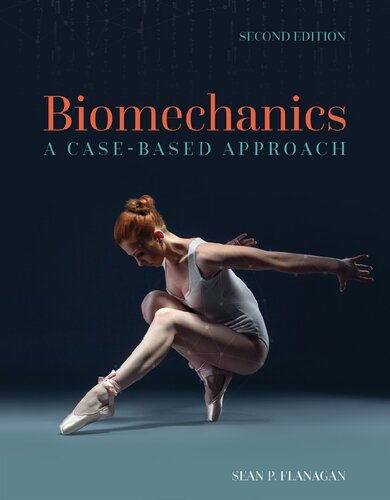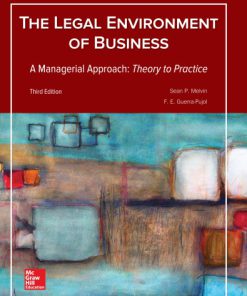Biomechanics A Case Based Approach Second Edition by Sean P Flanagan 1284102343 9781284102345
$50.00 Original price was: $50.00.$25.00Current price is: $25.00.
Biomechanics A Case Based Approach Second Edition by Sean P Flanagan – Ebook Instant Download/Delivery ISBN(s): 9781284102345,1284102343

Product details:
- ISBN 10: 1284102343
- ISBN 13: 9781284102345
- Author: Sean
Each new print copy includes the Navigate Companion Website which includes a variety of learning tools .The second edition of Biomechanics: A Case-Based Approach emphasizes the comprehension, retention, and application of the core concepts of biomechanics through the use of problem-based learning strategies. The author utilizes a student-centered approach by deploying a conversational writing style, tying new concepts to everyday experience, and emphasizing concepts over computation. A wide variety of pedagogical features aid this approach, with Section Questions, Competency Checks, and various boxed features serving to reinforce the content.Biomechanics: A Case-Based Approach is organized into 18 lessons that cover the three levels of biomechanical analysis: whole body, joint, and tissue. Rather than moving from one level to the next, the author deploys a “whole-part-whole” organization in which mechanical principles are described at the whole-body level, followed by relevant discussion of the basic material mechanics of biological tissues and unique properties of the muscle-tendon complex.Key Features:- NEW – Process Boxes illustrate the link between inputs and outputs, providing a visual depiction of the underlying mechanics.- NEW – Nine detailed case studies have been added throughout the text, with a summary of all nine cases presented in the final lesson.- EXPANDED – The use of vector diagrams has been greatly expanded in the Second Edition to help students better visualize key material.- KEY – Section Questions open each major section and present salient questions addressing the focus of the section.- KEY – Competency Checks ask students conceptual and quantitative questions to assist in gauging their understanding of the material.- KEY – Essential Math boxes provide a review of mathematical concepts.- KEY – Applied Research boxes provide examples that are helpful in illustrating biomechanical concepts and present evidence of the practical value of biomechanics.
Table of contents:
Lesson 1 Introduction
1.1 Biomechanics: Understanding the Rules Governing Movement
1.2 How to Use This Text
Summary
Review Questions
References
Part I The Whole Body Level
Lesson 2 Describing Motion: Linear Kinematics in One Dimension and One Direction
2.1 Preliminary Considerations: Representing Bodies of Interest and Establishing Frames of Reference
2.2 Position
2.3 Changing Position: Displacement and Distance
2.4 Rates of Change: Speed and Velocity
2.5 Acceleration
2.6 Gait
2.7 Case Studies
Summary
Review Questions
References
Lesson 3 Describing Motion: Linear Kinematics in One Dimension and Two Directions
3.1 Preliminary Considerations
3.2 Position
3.3 Displacement (Δp) and Distance (d)
3.4 Velocity (v)
3.5 Acceleration (a)
3.6 Case Study
Summary
Review Questions
Lesson 4 Describing Motion: Linear Kinematics in Two Dimensions
4.1 Preliminary Considerations: Frame of Reference
4.2 Resultants and Components
4.3 Net Values
4.4 Projectile Motion
4.5 Case Studies
Summary
Review Questions
References
Lesson 5 Describing Motion: Angular Kinematics
5.1 Angular Kinematics
5.2 Comparing Linear and Angular Kinematics
5.3 Relating Angular Kinematics to Linear Kinematics
5.4 Case Study
Summary
Review Questions
Reference
Lesson 6 Describing Motion: Inertia and Momentum
6.1 Inertia for a Body at Rest: Mass (m)
6.2 Inertia for a Body Moving Linearly: Linear Momentum (L)
6.3 Inertia for Angular Motion
6.4 Comparing Measures of Inertia
6.5 Phase Space
6.6 Case Studies
Summary
Review Questions
References
Lesson 7 Explaining Motion I: Linear Kinetics
7.1 Newton’s First Law
7.2 Newton’s Second Law
7.3 Contact Forces and Newton’s Third Law
7.4 Revisiting Newton’s Second Law
7.5 Types of Linear Resistances Used in Exercise
7.6 Case Studies
Summary
Review Questions
References
Lesson 8 Explaining Motion II: Angular Kinetics
8.1 The Angular Equivalent of the First Law
8.2 The Angular Equivalent of Newton’s Second Law
8.3 The Angular Equivalent of Newton’s Third Law
8.4 Angular Impulse and an Alternate View of Newton’s Second Law
8.5 Applications of Angular Kinetics
Summary
Review Questions
References
Lesson 9 Work–Energy
9.1 Energy
9.2 Work
9.3 Locomotor Work, the Center of Mass Equation, and the First Law of Thermodynamics
9.4 Efficiency and Economy
9.5 Power
9.6 Case Studies
Summary
Review Questions
References
Lesson 10 Collisions, Impacts, and the Conservation Laws
Introduction
10.1 Simple Collisions of Point Masses
10.2 More Complicated Collisions of Point Masses
10.3 Effective Mass
10.4 Case Study
Summary
Review Questions
References
Part II Tissue Level
Lesson 11 Mechanics of the Human Frame
Introduction
11.1 Basic Mechanics of Materials
11.2 Properties of Viscoelastic Materials
11.3 General Mechanics of Injury
11.4 Biomechanics of the Human Frame: Bone, Cartilage, and Ligaments
Summary
Review Questions
References
Lesson 12 Muscle–Tendon Mechanics
12.1 The Function of the Muscle–Tendon Complex (MTC)
12.2 The Individual Components
12.3 Factors Affecting MTC Mechanics
12.4 Injury Biomechanics
Summary
Review Questions
References
Part III Joint Level
Lesson 13 Single-Joint Concepts
13.1 Clinical Reference Frames
13.2 Kinematics
13.3 Kinetics
13.4 Joint Stability
Summary
Review Questions
References
Lesson 14 Lower Extremity Biomechanics
Introduction
14.1 The Foot and Ankle Complex
14.2 Knee Complex
14.3 Hip
Summary
Review Questions
References
Lesson 15 Biomechanics of the Axial Skeleton
Introduction
15.1 Basic Function and Structure
15.2 Region-Specific Mechanics
15.3 Spinal Injuries
Summary
Review Questions
References
Lesson 16 Upper Extremity Biomechanics
Introduction
16.1 The Shoulder Complex
16.2 The Elbow and Forearm
16.3 The Wrist and Hand
Summary
Review Questions
References
Part IV Limb Level
Lesson 17 Multijoint Concepts
Introduction
17.1 Kinematics
17.2 Kinetics
17.3 Case Studies
Summary
Review Questions
References
Part V Integrating the Levels
Lesson 18 Putting It All Together
Introduction
18.1 Analyzing and Improving Human Movement
18.2 Analyses of Select Basic Movements
18.3 Case Studies
People also search:
what are biomechanical concepts
biomechanics of a baseball swing
biomechanics basketball
application of biomechanics has a purpose to
applied biomechanics concepts and connections
You may also like…
Commercial & Financial Law
The Legal Environment of Business, a Managerial Approach: Theory to Practice Sean P Melvin
Business & Economics
Medicine - Psychiatry
A Case-Based Approach to Emergency Psychiatry 1st Edition Maloy
Uncategorized












